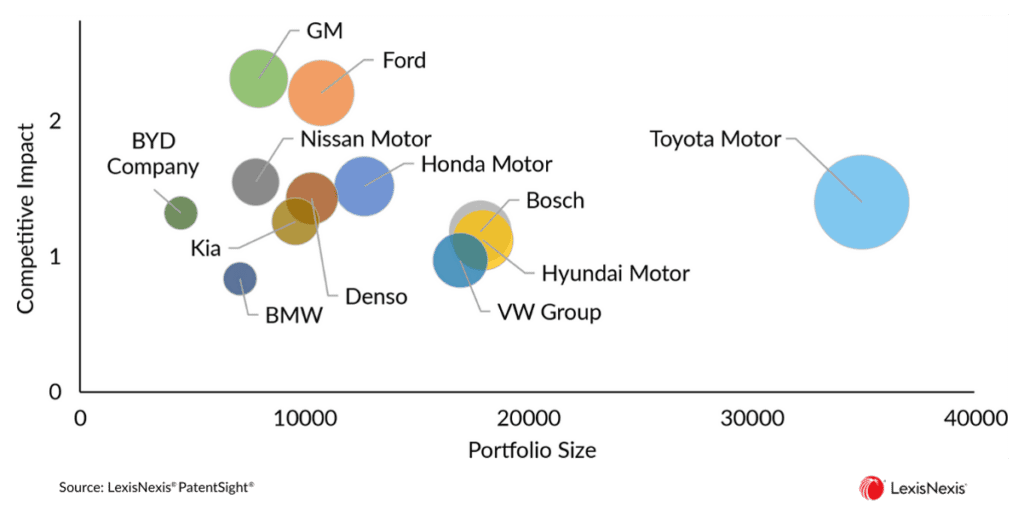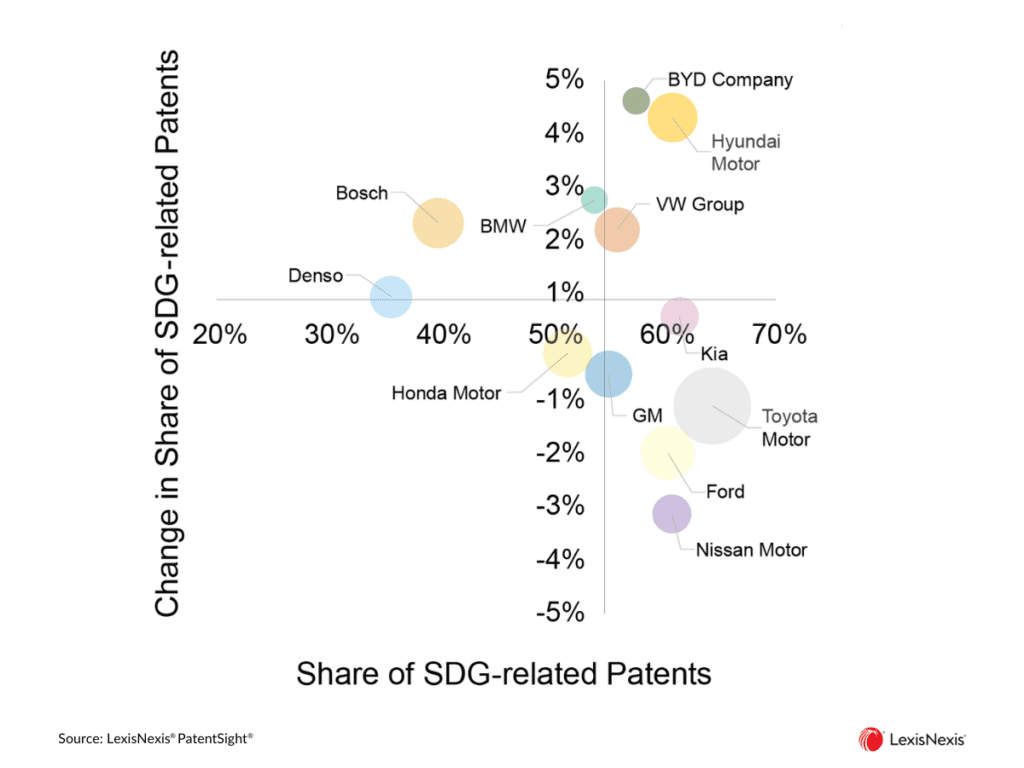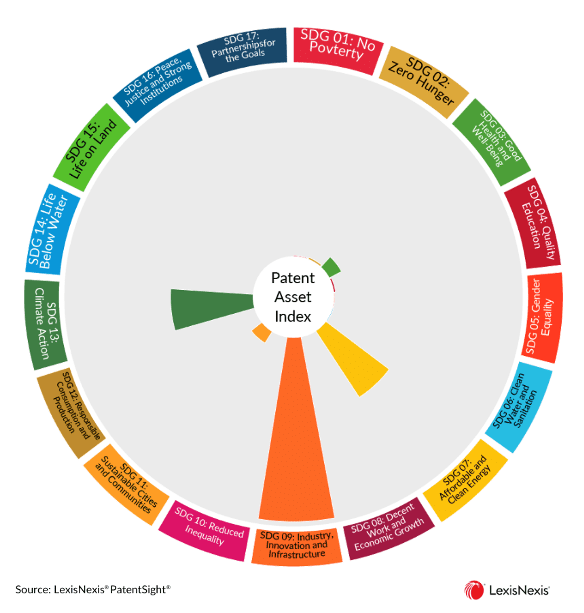The Green Race: Using Patent Data to Uncover Insights Into the Future of Automotive Sustainability

The automotive industry, a cornerstone of the global economy, is undergoing a monumental shift. As we navigate the 21st century, the industry historically considered a significant polluter increasingly focuses on creating environmentally friendly solutions, strongly emphasizing sustainable transportation. This is not just about branding or lifestyle choices. The industry’s commitment to sustainability is a response to increasing environmental concerns and a strategic move to future-proof businesses against a backdrop of tightening regulations and changing consumer preferences. At the same time, according to a PwC report, investors and lenders are becoming increasingly interested in understanding the climate risks that car manufacturers and suppliers face. They aim to avoid any negative impact on their reputation that may arise from being associated with non-environmentally friendly organizations.
Our recent report, “Exploring the Global Sustainable Innovation Landscape: The Top 100 Companies and Beyond,” identifying the world’s sustainable innovation leaders, found that many automotive industry innovators are leading the way toward a cleaner, safer, and more inclusive world. Despite their challenges, the industry is showing remarkable resilience and innovation. Companies are rethinking their business models, investing in new technologies, and making sustainability a core business principle. They’re reducing their environmental impact, creating value for stakeholders, and contributing to broader sustainable development goals.
Industry leaders with the most impactful patent portfolios in automotive sustainability
Our report utilizes a sophisticated method of mapping patents to the targets and indicators of the Sustainable Development Goals (SDGs) to identify worldwide leaders in sustainable innovation with robust patent portfolios. The report highlights the top 100 innovators, among whom 12 patent owners belong to the automotive industry. These include well-known original equipment manufacturers like Toyota Motor, VW Group, Honda Motor, and Kia and suppliers like Bosch and Denso. Each of these companies boasts a substantial collection of SDG-relevant patents.
In Figure 1, Portfolio Size, which represents the number of SDG-relevant patents in a portfolio, is illustrated on the horizontal axis, and the average quality of patents in the portfolio, as measured by our proprietary average patent family quality metric Competitive Impact, is on the vertical. Toyota Motors is the leader of the pack in sustainable innovations in the Automotive space, with the largest and most robust portfolio as measured by the Patent Asset Index (represented by the bubble size).
Figure 1: Average patent family quality (Competitive Impact) versus portfolio size of patent owners in the Automotive industry sector by their SDG-related patent portfolios. The bubble size of the patent owners represents the portfolio strength (Patent Asset Index).
Interestingly, Tesla, the electric vehicle pioneer, is missing from the list. This is primarily since, despite contributing to lowering carbon emissions, Tesla licenses a large share of its technology. This meant the Tesla portfolio did not meet the minimum requirement for SDG-related patents to be included in the report.
Another interesting point is that in terms of Competitive Impact or average quality, measured on the vertical axis, General Motors and Ford are the leaders among the automotive industry companies. Ford has the second strongest portfolio among automotive manufacturers due to this high average quality, even though they own a smaller portfolio of SDG-related inventions.
Sustainability share: How committed are the automotive industry leaders?
When assessing a company’s commitment to sustainability, it’s essential to analyze the proportion of sustainable innovation in its portfolio and its growth over the last five years. Figure 2 displays this data, with the share of sustainable innovation on the horizontal axis and the change in share over the past five years on the vertical axis (measured by the change in number of active patents related to sustainability between 2017-2022).
Figure 2: The share of SDG-related patents of Automotive companies and its change (or dynamics) between 2017 and 2022.
Companies with over 50% share of sustainability technologies in their portfolios are located on the right of the graph. Interestingly, some of the top sustainable innovators in this industry haven’t increased their SDG-related patent holdings over the last five years. However, China’s BYD has experienced the most significant increase in the share of SDG-related patents, surpassing VW and Hyundai with more than twice the growth of the former. Additionally, while Toyota Motor has the largest share of SDG-related patents, they have experienced a slight decrease during the observed period.
Automotive companies in the Top 100 have made significant innovations in electric vehicles, including hybrid, plug-in hybrid, fuel cell, and all-electric vehicles. When we looked at the combined portfolio of the 12 automotive companies that made it to our Top 100 companies, we found that most of their patents related to SDGs are directed towards SDG 9: Industry, Innovation, and Infrastructure. The second-most patents are for SDG 7: Affordable and Clean Energy (as shown in Figure 3), which aims to provide universal access to affordable, sustainable, and modern energy.
Figure 2: The strongest SDG-related portfolios of the Automotive industry as measured by Patent Asset Index.
Patent analytics leads the way: Stay ahead in the automotive sustainability race
As we look to the future, it’s clear that the automotive industry is not just driving toward sustainability; it’s racing toward it. With each innovation and initiative, the industry is getting closer to a future where cars are not just a means of transportation but a symbol of our commitment to a sustainable future. The journey towards sustainability is a challenging one. Still, with the dedication and innovation demonstrated by the industry, it’s a journey that promises to lead to a greener, more sustainable future.
In the automotive market, a brand’s long-term sustainability is not solely determined by market shares. Technology companies can utilize patent analysis to evaluate their innovative potential and establish themselves as market leaders, effectively influencing consumer decisions and communicating with stakeholders. Through patent analytics, car manufacturers can demonstrate their dedication to supporting sustainable progress through technology development. By highlighting their technological advancements, energy-efficient designs, and eco-friendly manufacturing processes, they can garner the trust and loyalty of consumers seeking sustainable alternatives. Tools like LexisNexis® PatentSight®, which produces advanced insights into portfolios with easy-to-grasp visuals, make it easy for everyone to understand your company’s commitment to sustainability.
Ready to show the world your company’s commitment to sustainability? Schedule a tailored portfolio review with one of our experienced analysts here.

Unveiling the Top Contributors to the Global Sustainability Agenda
Be at the forefront of sustainability progress. Download our game-changing IP report for a comprehensive view of the world’s top contributors to the UN Sustainable Development Goals.



